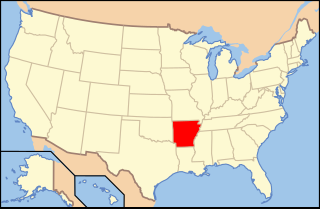
The following is an alphabetical list of articles related to the U.S. state of Arkansas.

The University of Arkansas Campus Historic District is a historic district that was listed on the National Register of Historic Places on September 23, 2009. The district covers the historic core of the University of Arkansas campus, including 25 buildings.

This is a list of the National Register of Historic Places listings in Poinsett County, Arkansas.
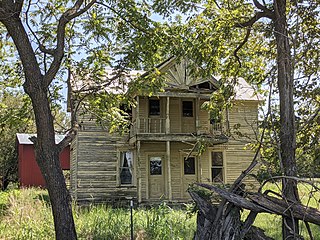
The Bacon Hotel, also known as the Sunrise Hotel, is a historic hotel building at the southeast corner of Railroad and Homestead Roads in Whitehall, Arkansas. It is a two-story wood-frame structure, with a cross-gable roof and a two-story porch extending across its front. The porch is supported by spindled wooden posts, and the front gable end features a large carved sunburst design. There are four guest rooms on each floor; those on the second level are accessed via outside stairs. The hotel was built in 1912, during the area's timber boom, and is one of the few surviving reminders of that period. It is also one of the state's finer railroad-era Folk Victorian hotels.
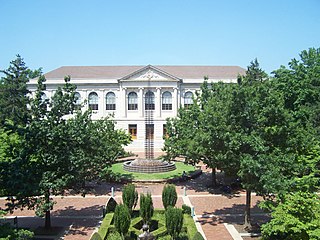
Vol Walker Hall is a building on the University of Arkansas campus in Fayetteville, Arkansas. It contains the Fay Jones School of Architecture and Design. The structure was added to the National Register of Historic Places in 1992.

The Bunch-Walton Post No. 22 American Legion Hut is a historic social club meeting hall at 201 Legion Street in Clarksville, Arkansas. It is architecturally unique in the community, built out of native stone in the manner of a Norman castle. It is two stories in height, with rounded projecting corners and a crenellated parapet. Its main entrance is set in a rounded-arch opening at the center of the front facade, and is elevated, with access via flight of stairs. It was built in 1934, and is believed to be the only American Legion hall of this style in the state.

The Willie Lamb Post No. 26 American Legion Hut is a historic society meeting hall at 205 Alexander Street in Lepanto, Arkansas. It is a single story brick building with a side-gable roof, and a full-width shed-roof front porch supported by square posts. It was built in 1937-38 for the local chapter of the American Legion military fraternal organization, replacing an earlier building which had been built with funding assistance from the New Deal Civil Works Administration in 1932 which was flooded and then destroyed by fire. The building has long been a center of social activity in the community, as the site of dances, fundraising events, and other activities.

Judd Hill is an unincorporated community in Poinsett County, Arkansas, United States. Judd Hill is located on Arkansas Highway 214, 5 miles (8.0 km) south of Trumann. The Judd Hill Cotton Gin, which is listed on the National Register of Historic Places, is located in Judd Hill. Judd Hill was named for banker and businessman Orange Judd Hill, who founded the community.
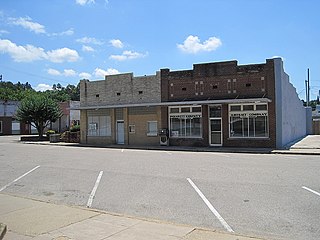
The Harrisburg Commercial Historic District encompasses the historic civic and commercial heart of Harrisburg, Arkansas, the county seat of Poinsett County, located in the far northeastern part of the state. The district encompasses the buildings surrounding Court Square, where the Poinsett County Courthouse is located, and extends a short way north and south on Main and East Streets. Although Harrisburg was founded in 1856, its substantial growth did not begin until after the arrival of the railroad in the 1880s. The oldest building in the district is the Harrisburg State Bank building at 100 North Main. The courthouse is a grand Classical Revival structure built in 1917. Most of the district buildings were built before the Great Depression, using brick or masonry construction.

The Hubbard Rice Dryer is a historic rice processing facility at 15015 Senteney Road, about 7 miles (11 km) northeast of Weiner, Arkansas. It consists of ten concrete silos 50 feet (15 m) in height, arranged in pairs retreating from the roadway, which passes to the south of the facility. In the interior spaces between these concrete silos are five metal silos, 40 feet (12 m) in height. Large metal pipes protrude from the east and west side of the structure. Each silo is mounted on a concrete ring, most of which have doorways providing access into the facility's substructure, which facilitates movement between the silos. Built c. 1945, it is a well-preserved example of a period rice dryer. It was last used in 1979, and has stood vacant since then.

The Lepanto Commercial Historic District encompasses the traditional commercial heart of the small city of Lepanto, Arkansas. The district includes one block of Greenwood Avenue between Berry and Holmes Streets, and portions of two more blocks at either end, as well as two blocks of Berry Street, with a few buildings on adjacent streets. Lepanto was founded in 1903, but its surviving commercial architecture only dates as far back as c. 1915, when the Portis Company cotton gin was built at the eastern end of the district. Other early buildings include the triangular {{circa|1920} Arlington Light and Power building at 320 Greenwood, and the unusual Barton's of Lepanto building at 111 Berny Street, built as a wood frame lumber yard office {{circa|1920); its walls were bricked in 1955 when it was converted to a hardware store.

The Marked Tree Commercial Historic District encompasses the historic commercial center of Marked Tree, Arkansas. It includes one city block of Frisco Street, between Nathan and Elm Streets, as well as two adjoining buildings on Elm Street. This area was developed commercially beginning with the arrival of the railroad in the 1880s, and was focused around the railroad depot, which no longer stands. All of the fifteen buildings in the district were built between 1910 and 1937, and exhibit typical early 20th-century commercial architecture, mostly executed in brick.

The Maxie Theatre was a historic movie theatre at 136 Arkansas Highway 463 South in Trumann, Arkansas. It is a single-screen theatre, housed in a large Art Deco structure built in 1948-9 by Zell Jaynes. At the time of its opening it featured the latest in amenities, including air conditioning, upholstered seats, and a fancy curtain to cover the screen. It also had a purpose-built segregated seating area for African-American in the balcony, with separate entrance, ticketing, and concession facilities. Until its closure in 2012 the theatre was one of oldest continuously-operating businesses in Trumann and was the town's only theatre.

The Modern News Building is a historic commercial building at 216 North Main Street in downtown Harrisburg, Arkansas. It is a single-story rectangular brick building, with a flat roof and simple styling. A tall front steps down toward the rear of the building, with the side walls capped in tile. The facade is three bays wide, with a center entry flanked by recessed windows. A metal awning extends across the facade. The building was built in 1888, and is significant as the home of The Modern News, which has been Harrisburg's newspaper since that year.
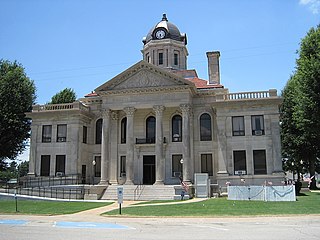
The Poinsett County Courthouse is located on a city block of downtown Harrisburg, Arkansas, bounded by Court, North Main, Market, and East Streets. It is a two-story granite and concrete structure, set on a raised foundation. The central block is topped by a tiled hip roof, with an octagonal tower set on a square base at its center. The front facade has a Classical Revival tetrastyle Corinthian portico with a fully enclosed gable pediment. Wings on either side of the main block are lower in height, but project beyond the main block's front and back. They are capped by low balustrade surrounding a flat roof. The courthouse was designed by Mitchell Seligman of Pine Bluff and built in 1917 to replace an earlier courthouse which had been destroyed by fire.

The Poinsett Lumber and Manufacturing Company Manager's House, also known locally as the Singer Mansion, is a historic house at 512 Poinsett Avenue in Trumann, Arkansas. It is a single-story structure, with a varied roof line, and multiple exterior sheathing materials, including brick and stucco with false half-timbering typical of the Tudor Revival style, and recently applied modern siding. The house was designed by Edwin B. Phillips and built in 1935 for the Poinsett Lumber Company to house its senior on-site manager. It is, despite the modern siding, the only Tudor Revival building in Trumann, and the only surviving residence associated with the Poinsett Lumber Company, a major area employer in the first half of the 20th century.

The Tyronza Commercial Historic District encompass much of the traditional commercial heart of the small city of Tyronza, Arkansas. It extends along the city's Main Street, southward from the railroad tracks for about three blocks, and includes 17 historically significant buildings, as well as Tyronza Park, a small city park. Most of the district's buildings were built between 1910 and 1930, the major period of Tyronza's growth, and are mostly typical commercial vernacular brick and masonry structures one and two stories in height. The oldest building in the district is the c. 1916 Bank of Tyronza building at 117 South Main. This building and a few others nearby now house a local history museum.

The Tyronza Methodist Episcopal Church, South is a historic church building at 129 Church Street in Tyronza, Arkansas. It is a single-story masonry structure, built out of orange brick laid on a raised basement. Its main facade, facing west, has a projecting vestibule with shallow-pitch roofline matching that of the main roof, and is approached by a broad and shallow flight of stairs. Windows on this facade are narrow, with rounded-arch tops, while other windows on the building are either arched or rectangular sash. The church was built in 1928, and is a good local example of Classical Revival design. Its architect is unknown; its design resembles that of the Wabbaseka Methodist Episcopal Church, South.

The Robert E. Lee School is a historic former school building at 3805 West 12th Street in Little Rock, Arkansas. Now a local community and social service center, this Collegiate Gothic revival two-story masonry building was built in 1906-07 and twice enlarged. The original design was by Gibb & Sanders, and the additions were by Theo Sanders (1910) and Thomas Harding, Jr. (1930). The city used the building as a school until 1971. In the 1990s it was used as a teacher training facility, and was in 2005 repurposed as a community center.
Poinsett most often refers to Joel Roberts Poinsett (1779-1851), American physician and diplomat, namegiver for many of the other meanings.


















